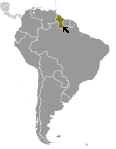World Atlas: Guyana. On this page you can see the map, country flag and many detailed information about the people, history and economy of Guyana.

Here you can find online selected information about the geography, inhabitants, government, economy and history of Guyana. Included are selected statistics, an overview map and the detailed map of Guyana. But let's start with the flag of Guyana here:
Guyana - Overview:
What you should know about Guyana? Let's start with this: Originally a Dutch colony in the 17th century, by 1815 Guyana had become a British possession. The abolition of slavery led to settlement of urban areas by former slaves and the importation of indentured servants from India to work the sugar plantations. The resulting ethnocultural divide has persisted and has led to turbulent politics. Guyana achieved independence from the UK in 1966, and since then it has been ruled mostly by socialist-oriented governments. In 1992, Cheddi Jagan was elected president in what is considered the country's first free and fair election since independence. After his death five years later, his wife, Janet Jagan, became president but resigned in 1999 due to poor health. Her successor, Bharrat Jagdeo, was elected in 2001 and again in 2006. Early elections held in May 2015 resulted in the first change in governing party and the replacement of President Donald Ramotar by current President David Granger
Geography of Guyana
 Where on the globe is Guyana? The location of this country is Northern South America, bordering the North Atlantic Ocean, between Suriname and Venezuela. Total area of Guyana is 214,969 sq km, of which 196,849 sq km is land. So this is not a large country. How could we describe the terrain of the country? This way: mostly rolling highlands; low coastal plain; savanna in south. The lowest point of Guyana is Atlantic Ocean 0 m, the highest point Laberintos del Norte on Mount Roraima 2,775 m. And the climate is tropical; hot, humid, moderated by northeast trade winds; two rainy seasons (May to August, November to January).
Where on the globe is Guyana? The location of this country is Northern South America, bordering the North Atlantic Ocean, between Suriname and Venezuela. Total area of Guyana is 214,969 sq km, of which 196,849 sq km is land. So this is not a large country. How could we describe the terrain of the country? This way: mostly rolling highlands; low coastal plain; savanna in south. The lowest point of Guyana is Atlantic Ocean 0 m, the highest point Laberintos del Norte on Mount Roraima 2,775 m. And the climate is tropical; hot, humid, moderated by northeast trade winds; two rainy seasons (May to August, November to January).
Inhabitants of Guyana
Let's take a look how many people live in Guyana. The number is: 737,718. So not so many people live here. Who lives here? East Indian 39.8%, black (African) 29.3%, mixed 19.9%, Amerindian 10.5%, other 0.5% (includes Portuguese, Chinese, white) (2012 est.). What are the languages in Guyana? English (official), Guyanese Creole, Amerindian languages (including Caribbean and Arawak languages), Indian languages (including Caribbean Hindustani, a dialect of Hindi), Chinese (2014 est.). And the religions: Protestant 34.8% (Pentecostal 22.8%, Seventh Day Adventist 5.4%, Anglican 5.2%, Methodist 1.4%), Hindu 24.8%, Roman Catholic 7.1%, Muslim 6.8%, Jehovah's Witness 1.3%, Rastafarian 0.5%, other Christian 20.8%, other 0.9%, none 3.1% (2012 est.). How old are the people in average? 26.2 years. We have to add that this number is the median - so one half of the people is older than this, one half is younger. And what is their life expectancy (at birth)? This: 68.6 years. Where the people live in Guyana? Here: population is heavily concentrated in the northeast in and around Georgetown, with noteable concentrations along the Berbice River to the east; the remainder of the country is sparsely populated. The major urban areas of Guyana are: Georgetown (capital) 124,000 (2014).
Government and Economy of Guyana
The capital of Guyana is Georgetown and the government type parliamentary republic. Let's take a look at the administrative divisions - 10 regions; Barima-Waini, Cuyuni-Mazaruni, Demerara-Mahaica, East Berbice-Corentyne, Essequibo Islands-West Demerara, Mahaica-Berbice, Pomeroon-Supenaam, Potaro-Siparuni, Upper Demerara-Berbice, Upper Takutu-Upper Essequibo. Regarding the economy of Guyana, important industrial products are bauxite, sugar, rice milling, timber, textiles, gold mining. Important agricultural products are sugarcane, rice, edible oils; beef, pork, poultry; shrimp, fish. The most important export commodities are sugar, gold, bauxite, alumina, rice, shrimp, molasses, rum, timbe and the most important export partners are Canada 30.6%, US 20.7%, Trinidad and Tobago 11.4% (2016). The most important import commodities are manufactures, machinery, petroleum, food and the most important import partners are Trinidad and Tobago 29%, US 27.5%, China 7.3%, Suriname 5.5% (2016). How rich is Guyana and how rich are people in this country? The most important number here is GDP per capita (PPP): $8,300 (2017 est.). This is quite a low number. Let's add that this means Gross Domestic Product per person, which is recalculated with respect to the relative cost of local goods and services. And one more important number - population below poverty line: 35% (2006 est.).